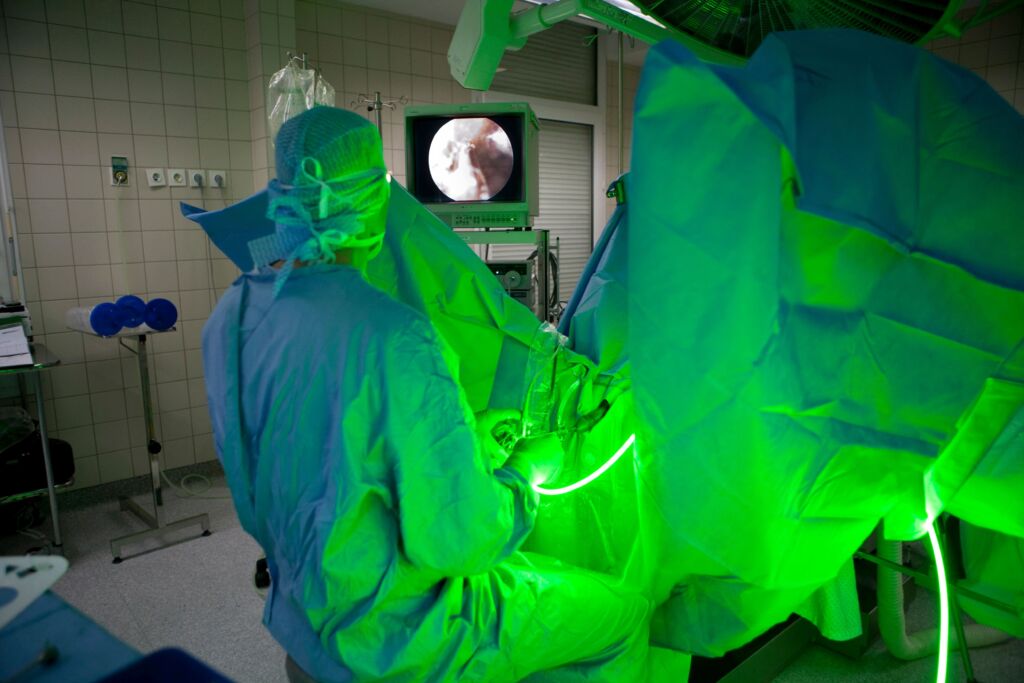What are the fields of application in urology?
Lasers can be used in the therapy of stones and soft tissues, and in urology this applies mainly to the prostate, but also in the ureter, urethra, bladder and kidney.
- Laser lithotripsy: This procedure is used to treat kidney, bladder or ureteral stones. The laser is used to break the stones into smaller fragments depending on the type of laser, or to atomize them completely, which facilitates passing or removal.
- Laser technology for benign enlarged prostate: If benign enlargement of the prostate is present (benign prostatic hyperplasia, BPH), different types of lasers can be used to remove excess prostate tissue and relieve urinary symptoms. A major advantage of laser surgery for BPH is that blood vessels are obliterated by the heat generated, thus minimizing bleeding. This makes these types of therapy particularly suitable for patients on blood thinners.
- Laser enucleation of the prostate is an established treatment method that uses laser light to separate the prostate tissue and push it into the urinary bladder. There, the prostate pieces are crushed and flushed out.
- Laser vaporization of the prostate gently vaporizes the tissue and thus reduces the volume of the prostate. With vaporization, subsequent examination (pathology) of the destroyed tissue is no longer possible, so accurate prior clarification for other diseases such as prostate cancer is important.
- Laser enucleation of bladder tumors: For superficial bladder tumors, lasers can be used to vaporize or destroy abnormal tissue without invasive surgery. This technique is minimally invasive, very low bleeding, and can be performed with mild anesthesia.
Which lasers are used at the Clinic for Urology at the USZ?
Thulium fiber laser
The thulium fiber laser is a state-of-the-art and very versatile laser. Since 2020, the Clinic of Urology has this laser in its repertoire as the first urological center in Switzerland.
The thulium fiber laser is a kind of solid-state laser that uses the thulium-doped fiber laser crystal (thulium-doped fiber laser) as the laser medium. This laser generates an infrared laser beam with a wavelength in the range of about 1800-2100 nm.
The use of the thulium fiber laser enables the use of very thin and flexible fibers. This allows the use of very fine and flexible instruments, which provide a better view of the target site and contribute to safety and precision during surgery. This has a clear application advantage especially for complex kidney and bladder stones, which are atomized with the thulium fiber laser.
The laser has a comparatively high power with low heat generation, which spares surrounding tissue.
Field of application: The thulium fiber laser is characterized by its versatility, precision and efficiency and is therefore successfully used in our urology department for the treatment of various diseases:
- For complex kidney stones and other types of stones
- Gentle laser enucleation of the prostate (ThuFLEP) for benign prostate enlargement. Here, ThuFLEP is a very good alternative for patients with a very large prostate who would normally undergo open surgery.
- State-of-the-art enucleation of base tumors
Further information: Atomized,not smashed. Pulverizing kidney stones with the thulium laser – USZ
Holmium:YAG laser
The Holmium:YAG Laser (Holmium:Yittrium Aluminum Garnet Laser) is based on Holmium Doped Yttrium Aluminum Garnet (Ho:YAG) as the laser medium and generates an infrared laser beam with a wavelength of about 2140 nm. This laser has a penetration depth of 0.4 mm. The pulsed energy emitted is strongly absorbed by water and water-containing tissue. The holmium laser has the advantage of causing minimal thermal damage to surrounding tissue. This makes it well suited for the treatment of sensitive structures in the body.
Field of application: We use the Holmium:YAG laser for the destruction of smaller, uncomplicated kidney stones during ureteroscopy (URS).
Greenlight laser/ Greenlight laser:
The Greenlight laser derives its energy from an Nd:YAG laser sent through a lithium triborate crystal (GreenLight XPS™ Laser Therapy System ), bisecting the wavelength to 532 nm. This wavelength is strongly absorbed by hemoglobin in the blood, which means that the laser beam easily penetrates blood vessels and seals them at the same time.
Indication: vaporization of prostate tissue in benign prostatic hyperplasia.
More about Greenlight Laser Therapy

Carbon dioxide laser
TheCO2 laser can precisely cut or vaporize tissue, which makes it suitable for wart removal. It penetrates only about 0.1 mm into the skin and thus reduces scarring.
Field of application: In urology, we use theCO2 laser for the gentle ablation of genital warts.
How do medical lasers work?
The laser consists of an active medium that emits light and an excitation source that stimulates the medium to produce light. The active medium can be, for example, a crystal, gas, glass or dye. The excitation of the active medium causes it to emit light. The light is amplified by the laser process and produces high intensity and coherence (uniform wavelength and phase relationship).
Laser beams are monochromatic, which means that they have a single wavelength. The monochromatic wavelength of a laser can be in the range of spectral colors visible to the eye from violet to red (rainbow) or beyond. The biological effect is determined by the wavelength. Laser beams are directional, which means that they propagate parallel to each other in a narrow beam bundle.
The laser beam is directed at the tissue or area to be treated. The nature of the interaction depends on the type of laser and the target tissue. This allows very targeted applications to be made. The tissue absorbs the laser light depending on its color, structure and composition. When the light is absorbed, it is converted into heat energy. This heat energy can produce various effects in the tissue, such as tissue ablation (removal), coagulation (vaporization), or photothermolysis (destruction of cells by heat).
Because laser beams are highly focused and controllable, they allow precise treatment of the target tissue while causing minimal damage to surrounding healthy tissue. This makes them particularly useful for surgical procedures and other medical procedures.


